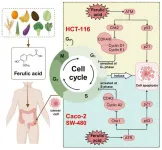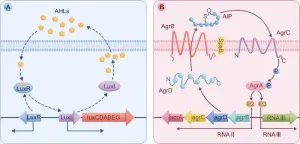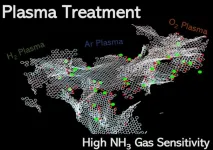Ferulic acid: a promising ally against colon cancer
2025-02-25
(Press-News.org)
Colon cancer continues to be one of the leading causes of cancer-related deaths worldwide, with poor dietary habits identified as a major risk factor. Ferulic acid, a phenolic compound abundant in many plant foods, has previously demonstrated potential anti-cancer properties by inhibiting cell proliferation and promoting apoptosis. Despite its promising effects, the impact of ferulic acid on colon cancer cells at different Duke’s progressive stages of the disease has remained largely unexplored. Given the critical need for new preventative measures, understanding the mechanisms through which ferulic acid acts on cancer cells is vital.
Published (DOI: 10.26599/FMH.2025.9420063) on November 26, 2024, in Food & Medicine Homology, the study conducted by researchers from Wuhan Polytechnic University and Kansas State University explored the effects of ferulic acid on colon cancer cells across different stages of Duke’s classification. Using three human colon cancer cell lines—SW-480, Caco-2, and HCT-116—the team examined the compound’s ability to inhibit cell proliferation, migration, and induce apoptosis, as well as the possibly associated signaling pathways.
The researchers found that ferulic acid significantly reduced cell viability in all three cell lines in a dose-dependent manner, with the HCT-116 cells showing the greatest sensitivity. Colony formation assays confirmed that ferulic acid effectively suppressed cell growth, reinforcing its anti-proliferative properties. In migration assays, including wound healing and transwell tests, ferulic acid significantly reduced cell movement, suggesting its potential to limit metastatic spread. Mechanistically, the compound induced cell cycle arrest: in SW-480 and Caco-2 cells, it halted progression at the S phase through the ATR/Chk1 pathway, while in HCT-116 cells, it caused arrest at the G1 phase via the ATM/Chk2 pathway. This was accompanied by downregulation of key cell cycle proteins such as CDK2, Cyclin A2, CDK4/6, and Cyclin D1/E1 complexes. Additionally, ferulic acid upregulated tumor suppressor proteins p53 and p21, which are pivotal in initiating apoptosis.
Dr. Xi Chen, one of the authors of the study, emphasized the significance of these findings, stating, “Our research provides a deeper understanding of how ferulic acid target colon cancer cells at various progressive stages classified by Duke’s system. This knowledge is crucial for developing effective dietary strategies aimed at preventing colon cancer.”
The results of this study suggest that incorporating ferulic acid-rich foods into the diet could serve as a promising strategy for colon cancer prevention. This approach aligns with the concept of food and medicine homology, emphasizing the role of natural compounds in combating cancer. Moving forward, clinical trials will be necessary to validate these findings and further explore the therapeutic potential of ferulic acid in colon cancer treatment.
This study is financially supported by Special Project of Central Government for Local Science and Technology Development of Hubei Province (No. 2022BGE247), Key Laboratory of Bulk Grain and Oil Deep Processing Ministry of Education (Wuhan Polytechnic University) (No. DZLY2023009), and the Program for Technical Innovation of Hubei Province (No. 2024BBB032).
END
[Attachments] See images for this press release:

ELSE PRESS RELEASES FROM THIS DATE:
2025-02-25
Pseudomonas aeruginosa is notorious for its role in food spoilage and infections, posing a significant threat to both food safety and human health. Traditionally, antimicrobial agents have been the go-to solution for managing contamination. However, the overuse of these agents has accelerated the development of drug resistance, leading to the emergence of multidrug-resistant strains that are difficult to treat. In response to this growing concern, the need for alternative methods to mitigate Pseudomonas aeruginosa’s pathogenicity ...
2025-02-25
An autonomous underwater vehicle can propel itself efficiently by using the energy in nearby water currents. Underwater and aerial vehicles must make their way through a complex environment of gusts and currents, fighting against many flows as they attempt to stay on course. Peter Gunnarson and John O. Dabiri designed an underwater robot that makes use of these flows to cut down on the energy needed to travel, “surfing” vortices to make its way to its destination. The palm-sized robot, CARL, was equipped with an onboard inertial measurement unit, ten motors to allow movement in all three axes, and a simple but effective algorithm: if ...
2025-02-25
Neuroimaging can capture brain activity in response to stimuli before a person decides how to respond. Initial affective responses—broadly good or bad feelings about a stimulus—have been associated with activity in evolutionarily conserved subcortical and cortical circuits including the Nucleus Accumbens (NAcc) and Anterior (AIns). Activity then continues through integrative circuits associated with more deliberative and reflective processing. Previous work has suggested that the early affective responses may be more ...
2025-02-25
Ask a Large language model (LLM) such as ChatGPT to summarize what people are saying about a topic, and although the model might summarize the facts efficiently, it might give a false impression of how people feel about the topic. LLMs play an increasingly large role in research, but rather than being a transparent window into the world, they can present and summarize content with a different tone and emphasis than the original data, potentially skewing research results. Yi Ding and colleagues compared a climate dataset of 18,896,054 tweets that mentioned "climate change" from January 2019 to December 2021 to rephrased tweets prepared by LLMs. The authors found that the ...
2025-02-25
Gas sensing technologies play a vital role in our modern world, from ensuring our safety in homes and workplaces to monitoring environmental pollution and industrial processes. Traditional gas sensors, while effective, often face limitations in their sensitivity, response time, and power consumption.
To account for these drawbacks, recent developments in gas sensors have focused on carbon nanomaterials, including the ever-popular graphene. This versatile and relatively inexpensive material can provide exceptional sensitivity ...
2025-02-25
New research highlighted in the journal CABI Reviews suggests that all five subregions of Africa will breach the 1.5°C climate change threshold – the limit stipulated by the Paris Agreement – by 2040 even under low emission scenarios.
A team of scientists, from the University of Zimbabwe, and the International Livestock Research Institute (ILRI) in Kenya, conducted a literature review to develop a framework for just transition pathways for Africa’s agriculture towards low emission and climate resilient development under 1.5°C of global warming.
They found that despite Africa ...
2025-02-25
Investigators from Mass General Brigham have conducted a multi-ancestry, whole genome sequencing association study of Alzheimer’s disease and found evidence for 16 new susceptibility genes, expanding the study of Alzheimer’s disease in underrepresented groups. Their results are published in Alzheimer’s & Dementia: The Journal of the Alzheimer’s Association.
For the study, co-led by Julian Daniel Sunday Willett, MD, PhD, and Mohammad Waqas, of the Genetics and Aging Research ...
2025-02-25
A new definition of dyslexia is needed to more accurately describe the learning disorder and give those struggling with dyslexia the specific support they require, says new research.
Dyslexia has had several different definitions over the years and this murky and complicated history means it can be a postcode lottery for children who may have dyslexia, or those who have been diagnosed but can’t access the support they need.
The first step to fixing this issue, new research has argued, is to redefine dyslexia and adopt the new definition across the UK.
The research was conducted by the University of Birmingham, the SpLD Assessment Standards Committee (SASC), Kings College London, ...
2025-02-25
More than half of women ages 30 to 35 are already suffering moderate to severe symptoms associated with menopause, yet most women are waiting decades before seeking treatment, new research from UVA Health and the Flo women’s health app reveals.
The research sheds important light on “perimenopause,” the transition period leading to menopause. Many women in perimenopause assume they’re too young to be suffering symptoms related to menopause, believing that symptoms won’t appear until they reach their 50s. But this ...
2025-02-25
Rebels of health care use technology to connect with clinicians, information, and each other
Cambridge, MA – February 25, 2025 – The future of health care is being forged in the crucible of rare disease. A new survey led by Susannah Fox, author of Rebel Health: A Field Guide to the Patient-Led Revolution in Medical Care (The MIT Press), finds that 15% of U.S. households are affected by rare disease or an undiagnosed illness. Their lives are characterized by extreme stress, often matched by their resourcefulness.
“People living with rare diseases push the edges of what is possible by using technology ...
LAST 30 PRESS RELEASES:
[Press-News.org] Ferulic acid: a promising ally against colon cancer




